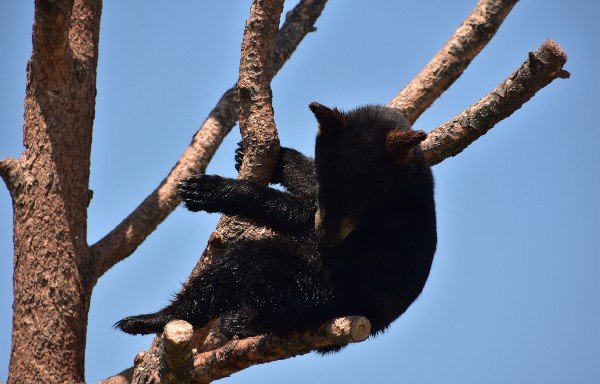Bears are fascinating omnivores with digestive systems that are less specialized compared to pure carnivores. Grizzly bears, in particular, have evolved to consume a varied diet, relying on both animal and plant matter. What sets bears apart from other carnivores is their ability to digest plant matter more efficiently, thanks to a relatively comprehensive digestive system. However, unlike ruminants, grizzly bears lack a cecum, which makes it difficult for them to fully break down the cellulose and lignin in plant material. To offset this limitation, they forage for plants when they are at their most nutritious and digestible stages of growth.
What Do Grizzly Bears Hunt and Eat?
Grizzly bears are opportunistic feeders that adjust their diet according to seasonal availability and nutritional content. The best foods for grizzly bears in the Greater Yellowstone Ecosystem (GYE) include army cutworm moths, whitebark pine nuts, ungulates, and cutthroat trout. These food sources provide the highest nutritional value for the least amount of foraging effort, making them essential for survival. Because food availability fluctuates yearly, the diet of grizzly bears can vary. Here, we’ll explore their feeding habits throughout the year.
Spring (March-May)
During early spring, grizzly bears primarily feed on ungulates such as elk and bison, often consuming carrion from animals that did not survive the winter or were killed by wolves. Grizzlies can also hunt young elk calves during this period. Large adult bison are a favored target, especially for giant male grizzlies, who are strong enough to overpower these massive creatures.
In regions with a healthy pocket gopher population, grizzly bears will dig up their burrows to access stored food caches. In addition to scavenging and hunting, bears will graze on the first shoots of succulent grasses, sedges, and forbs like dandelion, clover, and horsetail as they begin to green up in spring. Occasionally, grizzly bears may find and consume whitebark pine seeds cached by red squirrels, a valuable and nutrient-dense food from the previous autumn.
Summer (June-August)
As summer progresses, grizzly bears continue to consume a mix of plant and animal foods. Their plant-based diet includes nutrient-rich grasses, dandelions, clover, fireweed, and biscuit root. During this time, bears also consume army cutworm moths, which can provide a significant energy boost, as well as thistles and fern-leaved lovage. By mid-July, the ability of most grizzly bears to catch elk calves decreases, though some still hunt them.
Cutthroat trout become a major food source as they spawn in Yellowstone Lake and its tributaries. Additionally, as mid-summer arrives, grizzlies shift toward consuming more berries, including strawberries, globe huckleberries, grouse whortleberries, and buffaloberries. During late summer, the diet changes again as berries become scarce, and the bears switch to foraging for items like bistort, fake truffles, and yampa.
Notably, grizzlies are known to scavenge from other predators. They will steal carcasses from wolves, and during the late summer mating season for bison, grizzlies will feed on male bison that have been killed in combat with rival males.
Fall (September-October)
Fall is a critical time for grizzly bears as they prepare for hibernation by packing on as much weight as possible. In years when whitebark pine trees produce a large seed crop (referred to as a masting year), whitebark pine nuts become the most crucial food source. These nutrient-dense seeds help bears store essential fat reserves for the winter. However, whitebark pine doesn’t always produce a bountiful seed crop every year, so bears must adapt to other food sources when seeds are scarce.
During fall, grizzly bears also consume a variety of roots (such as bistort, sweet cicely, and yampa), berries, and other vegetation like clover, dandelion greens, and horsetail. Ants and army cutworm moths also make up part of their diet. In some regions, grizzlies may feed on human-grown crops like apples, pumpkins, and squash when they are accessible.
Elk rutting season in the fall provides grizzly bears with another valuable food source, as mature male elk become vulnerable after their energy-draining mating battles. Grizzlies will hunt or scavenge elk during this time, helping them further prepare for hibernation.
Grizzly Bears vs. Black Bears: Dietary Differences
While both grizzly bears and black bears share many dietary similarities, they have distinct preferences. Grizzly bears tend to consume more animal-based protein, especially from large prey and carrion, and rely more heavily on digging for roots and caches of small mammals. Their longer, straighter claws and powerful shoulder muscles make them adept diggers, helping them access food sources like roots, bulbs, and small rodents.
Black bears, by contrast, have shorter, more curved claws, which make them better climbers than diggers. They rely more heavily on plant-based foods, such as berries and nuts, and tend to eat less meat than grizzlies. In general, black bears consume more plant matter, while grizzlies incorporate a larger proportion of meat into their diet.
Conclusion
Grizzly bears are remarkable omnivores, capable of thriving on a diverse array of food sources that change with the seasons. While their plant digestion is less efficient than that of ruminants, they make up for this by selecting plants at their most nutritious phases and supplementing their diet with rich sources of animal protein. Grizzlies exhibit a dynamic and opportunistic feeding strategy, consuming everything from succulent grasses to large ungulates, ensuring their survival in the harsh and fluctuating environments of the Greater Yellowstone Ecosystem.






